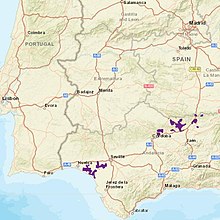Iberian lynx
The Iberian lynx (Lynx pardinus) is a feline. It is similar to other versions of the genus Lynx. The Iberian lynx has almost no threats except man, but it is almost extinct. It is the most endangered cat species in the world.[3]
| Iberian lynx | |
|---|---|

| |
| Scientific classification | |
| Domain: | Eukaryota |
| Kingdom: | Animalia |
| Phylum: | Chordata |
| Class: | Mammalia |
| Order: | Carnivora |
| Suborder: | Feliformia |
| Family: | Felidae |
| Subfamily: | Felinae |
| Genus: | Lynx |
| Species: | L. pardinus
|
| Binomial name | |
| Lynx pardinus (Temminck, 1827)
| |

| |
| Distribution of Iberian Lynx, 2015 | |
Iberian lynx hunt rabbits. One of the strategies aimed at saving the species is to change the use of land in such a way that it becomes more attractive to rabbits, which can then be hunted by the lynx. This strategy also benefits other endangered species, such as the Spanish imperial eagle.
In 2014, the Iberian lynx is treated as a species inside the famly of lynx by many biologists, mainly because of its independent development on the Iberian peninsula. This has not always been the case: Beforehand, it was seen as a subspecies of the Eurasian Lynx.
In June 2024, the International Union for Conservation of Nature announced that the Iberian lynx had moved from endangered to vulnerable status for the first time since 1986, after the 2023 census showed a population of 2,021 specimens.[4]
Breeding programs
changeIn 2002, the Jerez Zoo confirmed it had three females and was developing a plan for a captive breeding program.[5] One of those females was Saliega, captured as a cub in April 2002.[5] She became the first Iberian lynx to breed in captivity, giving birth to three healthy kittens on March 29, 2005 at the El Acebuche Breeding Center, in the Doñana Nature Park in Huelva, Spain.[6] Over the following years, the number of births grew and additional breeding centers were opened. In March 2009, it was reported that 27 cubs had been born since the beginning of the program.[7] In 2009, the Spanish government planned to build a €5.5 million breeding center in Zarza de Granadilla.[7] Portugal established a breeding center in Silves.[8][9]
There were 14 surviving cubs in 2008 and 15 in 2009.[10] In 2010, intense rain and health issues resulted in lower reproductive success—14 born, 8 surviving[10]—but the next year, breeding centers recorded 45 births with 26 surviving kittens.[11] In 2012, breeding centers in Portugal and Spain reported a total of 44 survivors from 59 births,[11][12] while 2013 saw a total of 44 survivors out of 53 born.[13]
In March 2013, it was reported that Iberian lynx embryos and oocytes had been collected and preserved for the first time.[14] They were collected from Saliega and another female—both sterilized and retired from the breeding program—by Berlin's Leibniz Institute for Zoo and Wildlife Research and stored in liquid nitrogen at the Museo Nacional de Ciencias Naturales de Madrid (CSIC) for possible future breeding.[14]
References
change- ↑ "Fossilworks: Fonelas P-1". Archived from the original on 2020-09-28. Retrieved 2019-08-16.
- ↑ Rodríguez, A. & Calzada, J. (2015). "Lynx pardinus". The IUCN Red List of Threatened Species. 2015. IUCN: e.T12520A50655794. doi:10.2305/IUCN.UK.2015-2.RLTS.T12520A50655794.en. Retrieved October 29, 2018.
- ↑ Ward, Dan (2008). "LynxBrief" (PDF). IberiaNature. Retrieved May 30, 2011.
- ↑ "One of world's rarest cats no longer endangered". BBC. 2024. Retrieved June 20, 2024.
- ↑ 5.0 5.1 Gonçalves, Eduardo (April 2002). "Captured cubs hold future of Europe's tiger". The Guardian. London. Retrieved August 16, 2019.
- ↑ "Hopes raised by Spain lynx births". BBC News. March 30, 2005. Retrieved September 5, 2012.
- ↑ 7.0 7.1 "Endangered Iberian lynx cubs born in Spain". Associated Press. March 20, 2009. Retrieved July 1, 2011.
- ↑ Bratley, Carrie-Marie (June 27, 2013). "Silves-born Iberian lynx released in Spain". The Portugal News. Archived from the original on March 20, 2014. Retrieved May 17, 2014.
- ↑ Tomás, Carla; de Atayde, André (April 2, 2013). "Quinze crias de lince ibérico nascem em Silves" [Fifteen Iberian lynx cubs born in Silves]. Expresso.sapo.pt (in Portuguese). Archived from the original on March 20, 2014. Retrieved January 26, 2019.
- ↑ 10.0 10.1 Sierra, David (August 18, 2010). "Fallece 'Geo', uno de los cachorros de lince ibérico nacido en cautividad este año" [Death of 'Geo', one of this season's captive-born Iberian lynx cubs] (in Spanish). rtve.es.
- ↑ 11.0 11.1 "Nacen 59 ejemplares de lince esta temporada en el Programa de Cría en Cautividad" [59 lynx kittens born this season as part of the Captive Breeding Program]. Europa Press (in Spanish). June 17, 2012. Retrieved July 13, 2012.
- ↑ "Success in Silves as seven lynx cubs are born". The Portugal News. March 31, 2012. Retrieved July 13, 2012.[permanent dead link]
- ↑ "El programa de cría en cautividad del lince ibérico acaba la temporada con 44 cachorros" [The lynx captive breeding program ends the season with 44 cubs]. EFE (in Spanish). 20minutos.es. September 9, 2013.
- ↑ 14.0 14.1 "For the first time Iberian lynx embryos are collected and preserved". Forschungsverbund Berlin e.V. (FVB). phys.org. March 23, 2013.
Other websites
change- Media related to Lynx pardinus at Wikimedia Commons
- Data related to Lynx pardinus at Wikispecies
